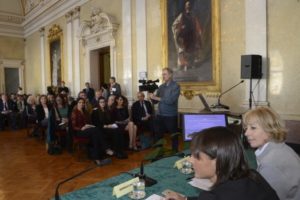CULTURE In Trieste, Discussing the Future of Miramare
A castle for the people of Europe, a park for diversity and cultural wealth to blossom. And the dream that investments on culture and creativity will bring prosperity, development and progress for the new generations too. Miramare Castle was built for Archduke Maximilian at the gates of Trieste, nestled between the Adriatic Sea and the Karst, between East and West, in the meeting point of the three European souls (Latin, Germanic and Slavic). The project for Miramare has been launched and a day of study and learning dedicated to the future of this extraordinary naturalistic and artistic area marks this historic turning point.
Many international experts were present, invited by the new director Andreina Contessa, who was previously managing the Museum of Italian Jewish art of Jerusalem. She came to Trieste to take up the challenge of one of the strategic projects on which the Ministry of Cultural Heritage focuses closely.
In the morning, historian Rossella Fabiani and botanist Mauro Tretiach gave the participants a tour of the huge historical, artistic and natural heritage of the castle and the park. Later in the day, the participants were welcomed by President of Friuli-Venezia Giulia Debora Serracchiani and an intense discussion on the work that needs to be done was held in the hall of the historic Lloyd Palace.
Ms Serracchiani said: “Today we send an important message. Minister Franceschini provided the funding necessary to start the renovations; this will correspond with the commitment of the local government and of all the people that see in Miramare the regaining of a collective mission for Europe.”
Andreina Contessa (in the picture with the President of the region) replied: “Miramare is not only a museum, a botanic garden and a marine park. It is also a laboratory, a place of study, research, training, education. It is also an important place for scientific research. And from this point of view, I hope that my experience in Jerusalem will be useful to put together a great project that can revitalize its potential. This is the reason why it’s important, before we listen to some of the great experts present, to give the floor to the young people, especially the young researchers that have recently devoted their studies to Miramare. This work we’re about to start must be undertaken for and with the young people.” Three young professionals, engineer Stefania Musto and architects Alessia Pellizzon and Giulia Ziberna, then presented several proposals on the arrangement of a unique park and natural and artistic heritage.
Mario Turetta, director of the Association of the Savoyard royal residences that manages the Palace of Venaria in Turin, brought the model of recovery and revitalization of the huge Piedmontese park. He observed: “It is the story of a success that required huge public investments, that maybe today aren’t possible. But we are talking about the Savoyard heritage under the portraits of Franz Joseph and Elisabeth of Austria that decorate this hall of the Lloyd Palace here in Trieste, and this is the sign of how many innovations we can build in today’s Europe.”
Brigitte Mang, director of the Foundation Dessau Wörlitz, previously head of the Austrian Federal Management of cultural parks, replied in German, recreating the environment of multilingualism and multiculturalism, of capital of minorities and identities that is typical of Trieste. She pointed out that the Miramare area should take up the message of love for human and natural diversity that the Archduke of Austria held dear. “It should innovate without betraying the original message and the actual purpose of Miramare, it should connect services and possibilities. These are the challenges of the future that Trieste will have to face to promote a heritage to be proud of. And during these challenges Trieste will not be alone, because Miramare is inextricably linked to the European horizon, an example for all the people and all the identities.”
Lastly, Andreas Kipar, President of Landscape Architecture Nature Development, reviewed some concrete models that could help lay the foundation for an overall project.
And while the great project takes shape, encouraging signs and substantial progress are increasing, and very attractive new routes for visitors are opening. The castle, that overlooks the sea from the top of a beautiful botanic garden, shows its original appearance again, the one that appear before the people who arrive from the sea. Minister Dario Franceschini has recently visited the area with the Chiefs of the railways companies. There is a desire to reconnect the great lines of the Southern and Transalpine railways, to reopen forgotten railway lines, and to connect the prestigious Central Europe Railway Museum, which will be in the Trieste Campo Marzio railway station, to the railway station that the Habsburgs wanted near Miramare park.
Andreina Contessa finally said: “The Miramare area can certainly represent one of the greatest tourist attractions of our country, but not only that. It could also be the space where art and nature meet in the name of the highest ideals and on the horizon of the best expectations that all European countries have in common.”
Translation by Sara Volpe, student at the Advanced School for Interpreters and Translators of Trieste University, and intern at the newspaper office of the Union of the Italian Jewish Communities.

